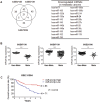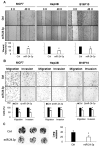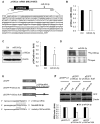The miR-24-3p/p130Cas: a novel axis regulating the migration and invasion of cancer cells
- PMID: 28337997
- PMCID: PMC5364481
- DOI: 10.1038/srep44847
The miR-24-3p/p130Cas: a novel axis regulating the migration and invasion of cancer cells
Erratum in
-
Author Correction: The miR-24-3p/p130Cas: a novel axis regulating the migration and invasion of cancer cells.Sci Rep. 2021 May 26;11(1):11395. doi: 10.1038/s41598-021-90393-2. Sci Rep. 2021. PMID: 34040050 Free PMC article. No abstract available.
Abstract
MicroRNAs (miRNAs) are small non-coding RNAs that negatively regulate gene expression by suppressing translation or facilitating mRNA decay. Differential expression of miRNAs is involved in the pathogenesis of several diseases including cancer. Here, we investigated the role of-miR-24-3p as a downregulated miRNA in metastatic cancer. miR-24-3p was decreased in metastatic cancer and lower expression of miR-24-3p was related to poor survival of cancer patients. Consistently, ectopic expression of miR-24-3p suppressed the cell migration, invasion, and proliferation of MCF7, Hep3B, B16F10, SK-Hep1, and PC-3 cells by directly targeting p130Cas. Stable expression of p130Cas restored miR-24-3p-mediated inhibition of cell migration and invasion. These results suggest that miR-24-3p functions as a tumor suppressor and the miR-24-3p/p130Cas axis is a novel factor of cancer progression by regulating cell migration and invasion.
Conflict of interest statement
The authors declare no competing financial interests.
Figures





Similar articles
-
Downregulation of microRNA-362-3p and microRNA-329 promotes tumor progression in human breast cancer.Cell Death Differ. 2016 Mar;23(3):484-95. doi: 10.1038/cdd.2015.116. Epub 2015 Sep 4. Cell Death Differ. 2016. PMID: 26337669 Free PMC article.
-
miR-223-3p Inhibits Human Osteosarcoma Metastasis and Progression by Directly Targeting CDH6.Mol Ther. 2018 May 2;26(5):1299-1312. doi: 10.1016/j.ymthe.2018.03.009. Epub 2018 Mar 14. Mol Ther. 2018. PMID: 29628305 Free PMC article.
-
PTTG1 regulated by miR-146a-3p promotes bladder cancer migration, invasion, metastasis and growth.Oncotarget. 2017 Jan 3;8(1):664-678. doi: 10.18632/oncotarget.13507. Oncotarget. 2017. PMID: 27893422 Free PMC article.
-
The important role of miR-1-3p in cancers.J Transl Med. 2023 Oct 31;21(1):769. doi: 10.1186/s12967-023-04649-8. J Transl Med. 2023. PMID: 37907984 Free PMC article. Review.
-
A review on expression and regulatory mechanisms of miR-337-3p in cancer.J Biomol Struct Dyn. 2024 Mar 18:1-10. doi: 10.1080/07391102.2024.2329294. Online ahead of print. J Biomol Struct Dyn. 2024. PMID: 38500239 Review.
Cited by
-
A Polysome-Based microRNA Screen Identifies miR-24-3p as a Novel Promigratory miRNA in Mesothelioma.Cancer Res. 2018 Oct 15;78(20):5741-5753. doi: 10.1158/0008-5472.CAN-18-0655. Epub 2018 Aug 2. Cancer Res. 2018. PMID: 30072395 Free PMC article.
-
Network-based analysis implies critical roles of microRNAs in the long-term cellular responses to gold nanoparticles.Nanoscale. 2020 Nov 7;12(41):21172-21187. doi: 10.1039/d0nr04701e. Epub 2020 Sep 29. Nanoscale. 2020. PMID: 32990715 Free PMC article.
-
Prognostic role of elevated mir-24-3p in breast cancer and its association with the metastatic process.Oncotarget. 2018 Feb 5;9(16):12868-12878. doi: 10.18632/oncotarget.24403. eCollection 2018 Feb 27. Oncotarget. 2018. PMID: 29560116 Free PMC article.
-
Crucial Roles of microRNA-Mediated Autophagy in Urologic Malignancies.Int J Biol Sci. 2021 Jul 31;17(13):3356-3368. doi: 10.7150/ijbs.61175. eCollection 2021. Int J Biol Sci. 2021. PMID: 34512152 Free PMC article. Review.
-
MiRNA 24-3p-rich exosomes functionalized DEGMA-modified hyaluronic acid hydrogels for corneal epithelial healing.Bioact Mater. 2022 Jul 15;25:640-656. doi: 10.1016/j.bioactmat.2022.07.011. eCollection 2023 Jul. Bioact Mater. 2022. PMID: 37056274 Free PMC article.
References
-
- Bartel D. P. MicroRNAs: genomics, biogenesis, mechanism, and function. Cell 116, 281–297 (2004). - PubMed
Publication types
MeSH terms
Substances
LinkOut - more resources
Full Text Sources
Other Literature Sources

